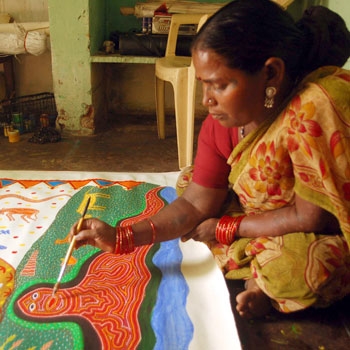Art requires talent; an eye for detail; and a vision. It doesn’t matter whether the art pertains to painting or sculpture. We’ve known of many artists who went to prestigious art schools, from where their careers took flight. But what about the indigenous and local artists, who have been practising their craft for generations? Where are their accolades? An artist who went from cashing casual employment checks to becoming a sought-after name is Padma Shri Bhuri Bai.

Who is Bhuri Bai?
Bhuri Bai is a renowned figure; a contemporary artist, muralist, and illustrator; known primarily for her Bhil art. She was born in Pitol village, Jhabua district, Madhya Pradesh to ‘Jhabbu Bai.’ While she was working as a daily wage construction labourer at the ‘Indira Gandhi Rashtriya Manav Sangrahalaya’ (Museum of Man) in Bhopal, she received a daily sum of Rs 6. It was here that she was scouted by J Swaminathan, who was impressed by her hut-weaving skills (a talent she learnt from her mother). Upon his recommendations, Bhuri Bai birthed exquisite Bhil art via acrylic on paper (her family’s ancestral horse), a stark contrast to her experience with colouring the walls of her home.

Bhuri Bai was the first artist from the Bhil tribe to have picked paper as her canvas. Due to her many contributions to the folk art form, she was awarded the 1986-87 ‘Shikhar Samman’ by the Madhya Pradesh Government. In 1998, she was awarded the ‘Ahalya Samman.’ In 2021, she was presented with the Padma Shri award. Bhuri Bai is a respectable name in the art community, having showcased her work in India, Europe, Australia, and the USA. One of her paintings, ‘Story of The Jungle’ won big at the 2007 Sotheby’s auction. She works at the ‘Adivasi Lok Kala Academy’ in Bhopal.
Bhuri Bai Painting Style
Some consider Bhil art to be the oldest tribal painting tradition in India. Bhuri Bai naturally is considered the baroness of Bhil. Her expertise lay in the vibrant multi-coloured dots; elongated forms, bordering on the surreal; and coiling & serpentine patterns. She focuses on creating traditional Bhil paintings, narrating mythological tales, rural life, and anthropomorphic animals. Keeping up with the time, she has also introduced modern-day phenomena such as smartphones, cars, and aeroplanes, ushering folk art into modernisation and industrialisation. Bhuri Bai paintings are a window to her hometown, describing the flora, fauna, Bhil culture, their deities, ornaments, and festivals.

Bhuri Bai is also adept at Pithora paintings, a ritual she observed and practiced since she was a child. Using cotton-wrapped ‘neem’ sticks and natural dyes (leaves, soot, and mud), she portrayed a diverse range of subjects, seldom unconventional. Under the guidance of J Swaminathan, who provided her with colours, readymade brushes, and canvas, she still used natural dyes, only moving to bright colours in the 1990s. Since then, her style has morphed into a fusion of experimental and traditional; engendering a distinct visual vocabulary.
Image Courtesy – India Art Fair
Be inclusive, be original, and always keep learning: Ina Puri shares her pearls of wisdom






